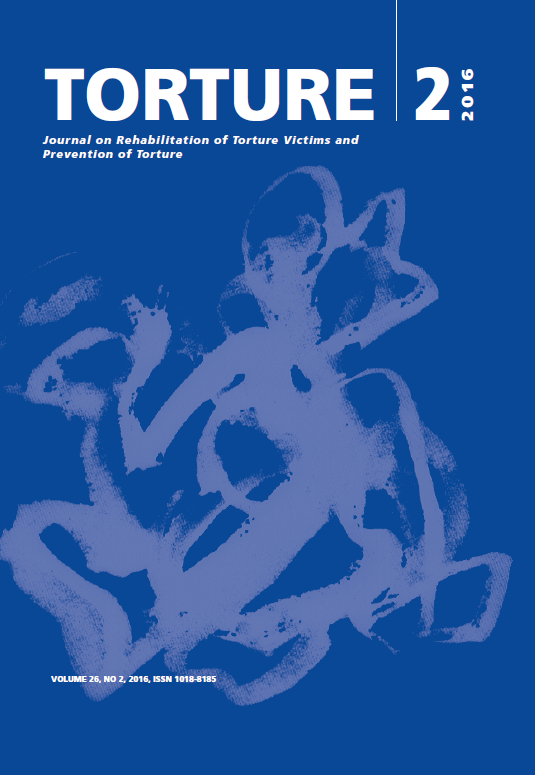Torture survivors’ symptom load compared to chronic pain and psychiatric in-patients
DOI:
https://doi.org/10.7146/torture.v26i2.108204Keywords:
functional disability, DRI (Disability Rating Index), HADS (Hospital Anxiety and Depression Scale), traumatized refugees, torture survivorsAbstract
Before their entry into the rehabilitation program at the Rehabilitation and Research Centre for Torture Victims (‘RCT’) in Copenhagen, the degree of symptoms of a group of resettled traumatized refugees was assessed by means of two rating scales: the Disability Rating Index (DRI) (n=197), measuring pain-related functional disability, and the Hospital Anxiety and Depression Scale (HADS) (n=147). The results obtained were compared with other patient populations, which included (1) a large Swedish mixed pain group and (2) various groups of pain patients previously investigated in the validation study of the DRI scale. The DRI scores of the refugee group were comparable to, or higher than, those of the pain groups, except for patients suffering from multiple sclerosis. The degree of anxiety and depression was found to be considerably greater in the refugee group than in the pain groups. Another recently published Danish study comparing traumatized refugees with psychiatric in-patients in terms of Health of Nation Outcome Scores (HoNOS) documented a higher degree of psychiatric disability for refugees. Based on the hypothesis that the observed differences in this study were underestimated due to the exclusion of refugees with psychotic symptoms and substance abuse, a partial re-analysis of the data was carried out by calculating effect sizes with and without the items measuring these symptoms. Controlling for the exclusion of the critical items resulted in a more pronounced difference between the refugees and psychiatric inpatients. Based on the data compared in this study, traumatized refugees are shown to suffer from multiple problems, including chronic pain, at a high symptom-level. This challenges prior clinical assumptions that single factors like PTSD can explain all symptoms.
References
2. Slobodin O, De Jong J. Mental health interventions for traumatized asylum seekers and refugees: What do we know about their efficacy? Int J Soc Psychiatry. 2015 Feb;61(1):17-26.
3. Fazel M, Wheeler J, Danesh J. Prevalence of serious mental disorder in 7000 refugees resettled in western countries: a systematic review. Lancet. 2005 Apr 9-15;365(9467):1309-14.
4. Panha P, Sopheap T, Harlacher U, Polatin P. Education as Treatment for Chronic Pain in Survivors of Torture and Other Violent Events in Cambodia: Experiences with Implementation of a Group-Based “Pain School” and Evaluation of Its Effect in a Pilot Study. Journal of Applied Biobehavioral Research, 2014 Mar;19(1)53–69.
5. Palic S, Lind Kappel M, Stougaard Nielsen M, Carlsson J, Bech P. Comparison of psychiatric disability on the health of nation outcome scales (HoNOS) in resettled traumatized refugee outpatients and Danish inpatients. BMC Psychiatry. 2014 Dec 18;14:330.
6. Salén, BA, Spangfort, EV, Nygren, AL, Nordemar R). The Disability Rating Index: an instrument for the assessment of disability in clinical settings. J Clin Epidemiol. 1994 Dec;47(12):1423-35.
7. Hawker GA, Mian S, Kendzerska T, French M. Measures of adult pain. Arthritis Care Res 63 (S11), S240–S252.
8. Zigmond AS, Snaith RP, "The hospital anxiety and depression scale". Acta Psychiatr Scand. 1983 Jun;67(6):361–370.
9. IBM Corp. Released 2015. IBM SPSS Statistics for Windows, Version 23.0. Armonk, NY: IBM Corp.
10. In-silico. T-test statistical calculator [Internet]. 2016-2016. [accessed 2015 Mar 1]. Available from: http://in- silico.nettools/statististics/ttest.
11. Stangroom J. Chi-square calculator [Internet]. 2016. [accessed 2015 Mar 1]. Available from: www.socscistatistics.com/tests/chisquare.
12. Psychometrica Institut für Psychologische Diagnostik. Berechnung von Effekstärken (2) Mittelwertsunterschiede zweier verscheiden grosser Gruppen (Cohen´s d, Hedges´ g). [Internet]. 2014-2016 [cited 2015 Mar 1]. Available from: www.psychometrica.de/effekstaerke.html.
13. Nationella Registret Över Smärtrehabilitering. Årsrapport 2008. [posted 2009 Jan 9; accessed 2015 Mar 1]. Available from: www.ucr.uu.se/nrs/ index.php/arsrapporter/cat view/55-arsrapporter.
14. Nationella Registret Över Smärtrehabilitering. Rapport 2014:1.-Årsrapport 2013 del 1. [updated 2014 Aug 9; accessed 2015 Mar 1]. Available from: www.ucr.uu.se/nrs/index.php/arsrapporter/cat view/55-arsrapporter.
15. UN Office of the High Commissioner for Human Rights (OHCHR), Manual on the Effective Investigation and Documentation of Torture and Other Cruel, Inhuman or Degrading Treatment or Punishment ("Istanbul Protocol"), 2004, HR/P/PT/8/Rev.1 Available at: http://www.refworld.org/docid/4638aca62.html.
Downloads
Published
How to Cite
Issue
Section
License
We accept that some authors (e.g. government employees in some countries) are unable to transfer copyright. The Creative Commons Licence Attribution-NonCommercial-NoDerivatives 4.0 International (CC BY-NC-ND 4.0) covers both the Torture Journal and the IRCT web site. The publisher will not put any limitation on the personal freedom of the author to use material contained in the paper in other works which may be published, provided that acknowledgement is made to the original place of publication.


